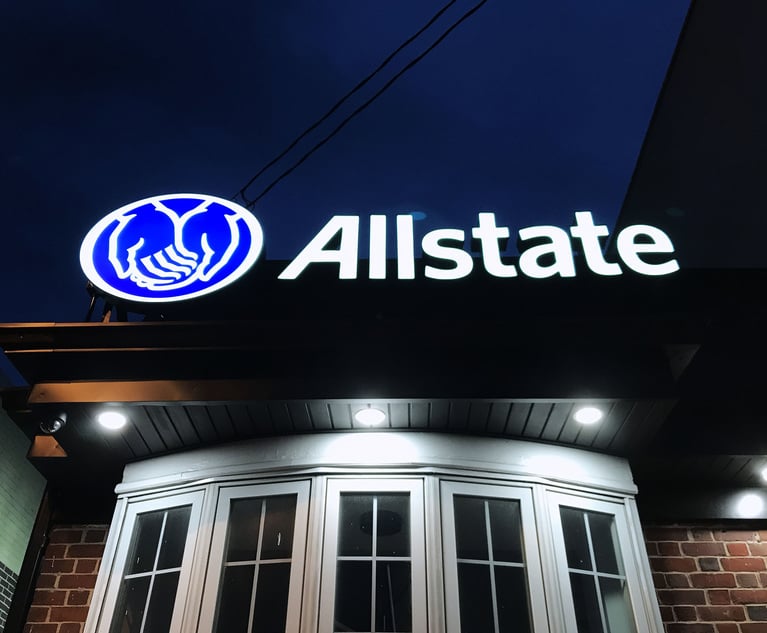Employee Nonsolicitation Clauses Are Not Enforceable in California
After decades of uncertainty, courts have now confirmed that California's strong public policy in favor of employee mobility prohibits the enforcement of employee nonsolicitation clauses.
June 11, 2019 at 12:45 PM
6 minute read
 Cheryl A. Cauley, partner with Taylor & Patchen.
Cheryl A. Cauley, partner with Taylor & Patchen.
Recognizing that noncompete provisions are invalid under California law, employers in California have long used employee nonsolicitation provisions in their employment agreements as an alternative strategy to limit competition for employees. Now, courts are making clear that this work-around is unacceptable, and that employee nonsolicitation clauses are impermissible in California.
Under California Business & Professions Code Section 16600, “every contract by which anyone is restrained from engaging in a lawful profession, trade, or business of any kind is to that extent void.” “Section 16600 expresses California's strong public policy of protecting the right of its citizens to pursue any lawful employment and enterprise of their choice,” see Dowell v. Biosense Webster, 179 Cal. App. 4th 564, 575 (2009). California courts have consistently confirmed that Section 16600 “evinces a settled legislative policy in favor of open competition and employee mobility,” as in Edwards v. Arthur Andersen, 44 Cal. 4th 937, 946 (2008).
With that strong public policy as a guide, California courts have explicitly held that noncompetition provisions, which prohibit former employees from working at a competitor for some period of time, violate Section 16600 because they impede employee mobility. As a result, California employers no longer include noncompetes in their employment contracts. Instead, many include an employee nonsolicitation clause, which prohibits former employees from reaching out to former coworkers to try to hire them at their new workplace.
The Chilling Effects of Employee Nonsolicitation Agreements
While not as obviously an impediment to employee mobility as noncompetes, nonsolicitation provisions limit employees' job opportunities due to the actual and perceived risk of enforcement and litigation. For example, consider Employee A who leaves Company 1—bound by a nonsolicitation agreement—to work at Company 2. Other Company 1 employees might worry about contacting Company 2 for a job because they don't want Employee A to be accused of violating his nonsolicitation agreement (a risk even if Employee A is not involved in the recruiting process). Company 2 might also hesitate to recruit or hire other employees from Company 1 because it does not want to have to defend threats or lawsuits from Company 1 relating to Employee A's nonsolicitation agreement. As a result, employees at both Company 1 and Company 2 are hindered in their ability to practice their chosen profession, trade or business by losing the opportunity to freely choose their jobs and their colleagues. And, aware of the chilling effects, employers often enforce or threaten enforcement of nonsolicitation provisions to prevent competitors from hiring their employees, even when a former employee did not affirmatively recruit those employees.
Until recently, employers have felt they may lawfully require employee nonsolicitation agreements from their employees because of the decades-old holding in Loral v. Moyes, 174 Cal. App. 3d 268 (1985). There, the California Court of Appeal for the Sixth District held that a provision prohibiting the employee-defendant from “raiding” the plaintiffs' employees was a “reasonable” restraint and thus permissible under Section 16600. In 2008, however, Edwards made clear that there is no “rule of reasonableness” under Section 16600; instead, subject to limited statutory exception, a restraint of any kind is improper. But because Edwards did not explicitly overrule Loral, and because the holding did not specifically address employee nonsolicitation provisions, employers continued to use such provisions without any check from the courts. That has now changed.
The Far-Reaching Implications of the AMN Decision
In November 2018, the California Court of Appeal for the Fourth District held that an employee nonsolicitation clause was invalid under Edwards and Section 16600. AMN Healthcare v. Aya Healthcare Services, 28 Cal. App. 5th 923, 936–39 (2018). In so holding, the court explained that Edwards' rejection of a “reasonableness” exception demonstrates that Loral's holding is likely no longer viable. To avoid that conclusion, some employers will likely point out that the nonsolicit in AMN applied to professional recruiters—on whom such clauses have a more obvious, direct impact—and will argue the holding should be limited to employees in that type of position. But, while the court mentions the employees' position as one basis for invalidity, its legal analysis under Edwards makes clear the decision extends to all employee nonsolicitation agreements. Two courts in the Northern District of California have since agreed, see Barker v. Insight Global, No. 16-cv-07186-BLF, 2019 WL 176260, at *2–*3 (N.D. Cal. Jan. 11, 2019); WeRide v. Huang, No. 18-cv-07233-EJD, 2019 WL 1439394, at *10–*11 (N.D. Cal. Apr. 1, 2019).
These decisions are likely to have far-reaching implications that will be felt immediately by employers and employees alike. The AMN court not only held that the nonsolicitation clause at issue was unenforceable, it also permanently enjoined the plaintiff-company from enforcing the clause against all other former employees. In addition, the court awarded attorney fees to the defendants because, by successfully showing the non-solicitation clause was unenforceable, they “conferred a significant benefit on the public.” Those holdings are likely to encourage additional lawsuits—perhaps on a class-wide basis—for declaratory relief on this issue. The increase of such lawsuits is especially likely because contracts that violate Section 16600 are, by definition, a violation of California's Unfair Competition Law, which allows for restitution, and may justify an award of attorney fees under Code of Civil Procedure Section 1021.5. See Cal. Bus. & Prof. Code Section 17200; Application Group v. Hunter Group, 61 Cal. App. 4th 881, 906–08 (1998) (finding a noncompete “in violation of Section 16600 to be a violation of Section 17200 as well”).
The Post-AMN Benefits to Employees
Employers are unlikely to be able to continue to use existing nonsolicitation clauses as a tool to prevent other companies from competing for their employees or to discourage current employees from leaving. This should have positive implications for employees, who will no longer feel hindered from following a former colleague to a new job, or recruiting former colleagues to a new venture. Further, if employers want to prevent such departures, they will need to convince employees to stay through incentives—such as increased pay or benefits, or improved work experience—rather than through threats and restraints. Although it took a decade after Edwards, courts have finally reached the logical conclusion compelled by California's strong public policy in favor of employee mobility: employee nonsolicitation agreements may no longer be enforced.
Cheryl Cauley is a partner with Taylor & Patchen in San Francisco who focuses her practice on complex commercial litigation and intellectual property disputes, representing clients in fields such as internet search and advertising, wireless communications and biotechnology.
This content has been archived. It is available through our partners, LexisNexis® and Bloomberg Law.
To view this content, please continue to their sites.
Not a Lexis Subscriber?
Subscribe Now
Not a Bloomberg Law Subscriber?
Subscribe Now
NOT FOR REPRINT
© 2025 ALM Global, LLC, All Rights Reserved. Request academic re-use from www.copyright.com. All other uses, submit a request to [email protected]. For more information visit Asset & Logo Licensing.
You Might Like
View All
State Appeals Court Revives BraunHagey Lawsuit Alleging $4.2M Unlawful Wire to China
3 minute read

Apple Disputes 'Efforts to Manufacture' Imaging Sensor Claims Against iPhone 15 Technology

Lawsuit alleges racial and gender discrimination led to an Air Force contractor's death at California airfield
7 minute readTrending Stories
Who Got The Work
J. Brugh Lower of Gibbons has entered an appearance for industrial equipment supplier Devco Corporation in a pending trademark infringement lawsuit. The suit, accusing the defendant of selling knock-off Graco products, was filed Dec. 18 in New Jersey District Court by Rivkin Radler on behalf of Graco Inc. and Graco Minnesota. The case, assigned to U.S. District Judge Zahid N. Quraishi, is 3:24-cv-11294, Graco Inc. et al v. Devco Corporation.
Who Got The Work
Rebecca Maller-Stein and Kent A. Yalowitz of Arnold & Porter Kaye Scholer have entered their appearances for Hanaco Venture Capital and its executives, Lior Prosor and David Frankel, in a pending securities lawsuit. The action, filed on Dec. 24 in New York Southern District Court by Zell, Aron & Co. on behalf of Goldeneye Advisors, accuses the defendants of negligently and fraudulently managing the plaintiff's $1 million investment. The case, assigned to U.S. District Judge Vernon S. Broderick, is 1:24-cv-09918, Goldeneye Advisors, LLC v. Hanaco Venture Capital, Ltd. et al.
Who Got The Work
Attorneys from A&O Shearman has stepped in as defense counsel for Toronto-Dominion Bank and other defendants in a pending securities class action. The suit, filed Dec. 11 in New York Southern District Court by Bleichmar Fonti & Auld, accuses the defendants of concealing the bank's 'pervasive' deficiencies in regards to its compliance with the Bank Secrecy Act and the quality of its anti-money laundering controls. The case, assigned to U.S. District Judge Arun Subramanian, is 1:24-cv-09445, Gonzalez v. The Toronto-Dominion Bank et al.
Who Got The Work
Crown Castle International, a Pennsylvania company providing shared communications infrastructure, has turned to Luke D. Wolf of Gordon Rees Scully Mansukhani to fend off a pending breach-of-contract lawsuit. The court action, filed Nov. 25 in Michigan Eastern District Court by Hooper Hathaway PC on behalf of The Town Residences LLC, accuses Crown Castle of failing to transfer approximately $30,000 in utility payments from T-Mobile in breach of a roof-top lease and assignment agreement. The case, assigned to U.S. District Judge Susan K. Declercq, is 2:24-cv-13131, The Town Residences LLC v. T-Mobile US, Inc. et al.
Who Got The Work
Wilfred P. Coronato and Daniel M. Schwartz of McCarter & English have stepped in as defense counsel to Electrolux Home Products Inc. in a pending product liability lawsuit. The court action, filed Nov. 26 in New York Eastern District Court by Poulos Lopiccolo PC and Nagel Rice LLP on behalf of David Stern, alleges that the defendant's refrigerators’ drawers and shelving repeatedly break and fall apart within months after purchase. The case, assigned to U.S. District Judge Joan M. Azrack, is 2:24-cv-08204, Stern v. Electrolux Home Products, Inc.
Featured Firms
Law Offices of Gary Martin Hays & Associates, P.C.
(470) 294-1674
Law Offices of Mark E. Salomone
(857) 444-6468
Smith & Hassler
(713) 739-1250






